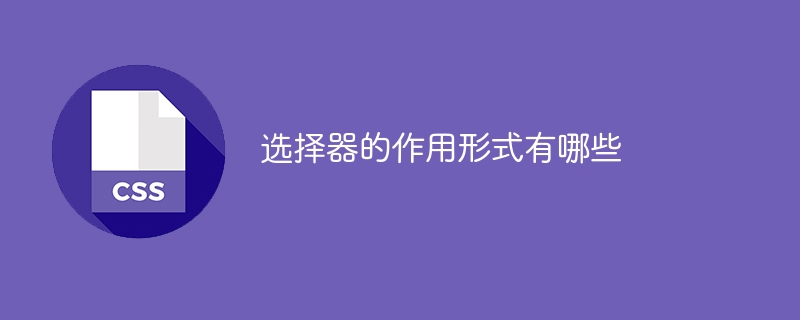
The functions of selectors are: 1. Element selector; 2. Class selector; 3. ID selector; 4. Attribute selector; 5. Pseudo-class selector; 6. Pseudo-element selector . Detailed introduction: 1. Element selector is the most basic selector. It selects elements according to the tag name of HTML elements; 2. Class selector selects elements through the class attribute of the element. The class selector starts with "." , followed by the class name; 3. ID selector, select the element through the ID attribute of the element, the ID selector starts with "#", followed by the ID name, etc.

The operating system for this tutorial: Windows 10 system, DELL G3 computer.
Selectors play an important role in CSS, allowing developers to specify exactly which elements should have a specific style applied. The main functions of selectors are as follows:
1. Element selector: The element selector is the most basic selector, which selects elements based on the tag name of the HTML element. For example, the p selector selects all
elements. The element selector is the default selector in CSS. If you only write CSS properties without writing a selector, it will default to the element selector.
2. Class selector: The class selector selects elements through the class attribute of the element. Class selectors start with . followed by the class name. For example, the .my-class selector will select all elements whose class attribute contains my-class. Class selectors can be used to apply different styles to elements of the same type, or they can be used to apply the same style to multiple elements.
3. ID selector: The ID selector selects elements through their ID attributes. The ID selector starts with # followed by the ID name. For example, the #my-id selector selects the element with the ID my-id. The uniqueness of the ID selector guarantees that it will only select one element, which makes it ideal for applying styles to specific elements on the page.
4. Attribute selector: Attribute selector selects elements through their attributes. For example, the [href] selector will select all elements with the href attribute, and the [href="value"] selector will select all elements with the href attribute value value. Attribute selectors can be used to apply styles to elements with specific attributes, and can also be used to apply different styles to elements with specific attributes.
5. Pseudo-class selector: Pseudo-class selector is used to select a specific state of the element. For example, the :hover selector selects elements when the mouse is hovering over them, and the :active selector selects elements that are activated by the user. Pseudo-class selectors can be used to apply styles to elements that are in a specific state, such as a button on mouseover or a clicked link.
6. Pseudo-element selector: Pseudo-element selector is used to select a specific part of the element. For example, the ::before and ::after pseudo-element selectors can insert content before and after the content of the element respectively. Pseudo-element selectors can be used to apply styles to specific parts of an element, such as underlining links or adding decorative content after text.
These selectors can be used individually or in combination to achieve more complex style and behavior control. For example, you can use a combination of class selectors and pseudo-class selectors to add a mouseover effect to elements of a specific class: .my-class:hover { color: red; }. At the same time, you can also use compound selectors such as wildcards, descendants, descendants, and unions to further narrow or expand the scope of selection.
In short, selectors in CSS provide multiple ways to precisely specify which elements should have a specific style applied, which allows developers to more flexibly control the style and layout of the page.
The above is the detailed content of What are the functions of selectors?. For more information, please follow other related articles on the PHP Chinese website!




